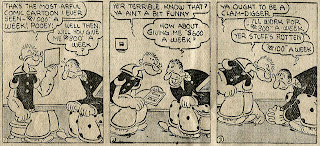
Number 243
"…I strongs to the finich..."
Animation fans of the Fleischer Brothers, and of Popeye cartoons, should be thrilled by the four-disk DVD set of the venerable sailor. Sixty cartoons, plus extras like documentaries on Popeye creator Segar, voice actors like Billy Costello and Jack Mercer as Popeye, and other extras like old Bray silents and Fleischer "Out Of The Inkwell" series cartoons. Whew. That's a lot, and like most of these types of compilations, comes at a price. I got mine for $42.99 from Amazon.
Like other Americans of my generation, I grew up with these cartoons on afternoon television, and also with the Popeye comics strips and comic books, then drawn by Bud Sagendorf. I knew there was a difference between the print Popeye and animated Popeye.
For one thing, with only seven minutes per cartoon to work with, there was no room for subtlety. They reduced the intricate storylines of the Segar strips down to a very basic formula: a love triangle, sexual jealousy, and cartoon violence. They also turned Popeye into a Fleischer character with the anthropomorphic stuff they were famous for; the Fleischers really understood how to use cartoons to their true potential. Rather than trying to duplicate reality in these early cartoons they made sure that reality rarely intruded.
In the 1934 cartoon, "Barnacle Bill," one of my favorites because most of the cartoon is sung using the popular song of the day, the formula is clear. Bluto, as Barnacle Bill, is Olive's boyfriend, even though Popeye refuses to go away. There is the inevitable fight, which Popeye wins after eating his spinach. When he beats Barnacle Bill the fickle Olive then wants him, but he doesn't want her. You could about set a stopwatch to each of the cartoons in the series to see when the fight would start, and there were endless variations on the actual fighting, but the outcome was always the same: the spinach, the victor, Popeye, gets the "prize," Olive.




 In the strip there was more room to tell a story. In this comic strip sequence from the same year, 1934, Popeye is a newspaper man, who hires a cartoonist, B. Loony Bullony, because comic cartoons is what readers want! I've scanned a sampling of these from the original printed strips, clipped from a newspaper of the day. The strips are printed longer than my scanner bed, so I've split them in half. There was a lot going on every day in the strip.
In the strip there was more room to tell a story. In this comic strip sequence from the same year, 1934, Popeye is a newspaper man, who hires a cartoonist, B. Loony Bullony, because comic cartoons is what readers want! I've scanned a sampling of these from the original printed strips, clipped from a newspaper of the day. The strips are printed longer than my scanner bed, so I've split them in half. There was a lot going on every day in the strip.



 The Segar Popeye and the Fleischer Popeye were two characters with the same name, appearance and some of the same subsidiary characters. Each medium had its own needs and limitations. Segar, in his silent strips, couldn't provide the catchy theme song, inspired gravelly Costello/Mercer voice of Popeye or the screech of Mae Questal's Olive. On the other hand, by reducing the animated Popeye to stories of such short length none of the richness of Segar's strip could be presented. Despite those differences, Popeye was one of the Twentieth Century's greatest comic creations. The cartoons are a joy to watch, just as the strips are a joy to read.
The Segar Popeye and the Fleischer Popeye were two characters with the same name, appearance and some of the same subsidiary characters. Each medium had its own needs and limitations. Segar, in his silent strips, couldn't provide the catchy theme song, inspired gravelly Costello/Mercer voice of Popeye or the screech of Mae Questal's Olive. On the other hand, by reducing the animated Popeye to stories of such short length none of the richness of Segar's strip could be presented. Despite those differences, Popeye was one of the Twentieth Century's greatest comic creations. The cartoons are a joy to watch, just as the strips are a joy to read.













{ 0 nhận xét... read them below or add one }
Đăng nhận xét